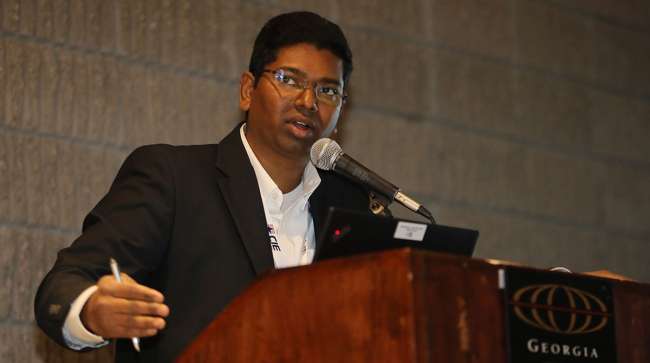Managing Editor, Features and Multimedia
TMC Aims to Help Fleets Navigate Complexity of Electric, Automated Vehicles

[Stay on top of transportation news: Get TTNews in your inbox.]
ATLANTA — As manufacturers and technology developers introduce electric-powered trucks and continue to test automated driving systems, the Technology & Maintenance Council is taking steps to help fleets navigate the complexity of these emerging technologies.
Three task forces within TMC’s Automated & Electric Vehicles study group met Feb. 24 to discuss these issues at the council’s 2020 annual meeting.
TMC’s Electrified Vehicle Task Force is looking at ways to help trucking operations unpack the many factors they must take into account as they consider adding electric vehicles to their fleets.
“I think TMC needs to be right in the thick of it” to help members deal with these new vehicles that are beginning to enter the market, said industry consultant Kevin Otto, who led the standing room-only meeting.
Otto presented several opportunities for TMC to develop recommended practices or reports on commercial vehicle electrification, including strategies for partnering with power companies.
“A lot of fleets that are trying to implement at least small numbers of electric vehicles in their operations have found that working and planning with electric utilities is really quite challenging,” he said.
Other suggestions include recommendations for charging station layout and installation, as well as maintenance procedures and required training for technicians working with high-voltage components.
Attendee Mike Moynahan of HEB Grocery encouraged TMC to proceed with its work on electric vehicles at an aggressive pace.
“It’s where we’re headed eventually, so the more we know about it, the safer we are, the sooner we can get our technicians trained, and the sooner we can get the vehicles on the road … the better off we’re going to be,” he said.
Today, HEB is operating four electric yard tractors built by Lonestar Specialty Vehicles at a location in San Antonio, Moynahan said.
Meanwhile, the Automated Vehicles Task Force is developing a questionnaire to help fleets ask the right questions as they speak with developers of automated driving systems and consider piloting their technology in their operations.
Ananda Pandy, the task force’s chairman, described the document as “a guidebook for the fleet” in such discussions.
“This questionnaire is to facilitate conversations between fleets and automated driving system vendors and developers, and to enable fleets to understand and evaluate the automated driving system features, operating conditions and technology maturity level for potential fleet trials,” said Pandy, who is technical specialist for advanced driver assistance systems and autonomy at ZF Group.
The draft document includes a range of questions about the specific applications in which a given system is designed to operate, including the types of roads and in which weather, lighting and traffic conditions.
Other potential questions ask about redundancy in sensing technology, braking and steering actuation systems, and how the system responds to emergency service vehicles such as police, ambulance and fire trucks.
Other priorities for the task force include developing key performance indicators to help fleets evaluate system performance and savings during trial deployments.
Other open questions include roadside inspection of automated vehicles and maintenance shop requirements for this technology.
Companies that are testing and developing highly automated driving systems for commercial trucks include TuSimple, Embark, PlusAI, Kodiak Robotics, Ike and Waymo. Truck makers and their suppliers also are investing in various forms of automated vehicle technology.
Finally, TMC’s task force on truck platooning discussed two main business models for this emerging technology, which uses vehicle-to-vehicle communications to enable two or more trucks to synchronize braking and travel on highways at short following distances.
Platooning with Level 1 automation requires the drivers in all vehicles to actively steer while the platoon is active, but can yield potential fuel savings through improved aerodynamics, which task force chairman Richard Bishop likened to “extreme drafting.”
Richard Bishop provides an overview of truck platooning concepts, including Level 1 platooning for enhanced fuel economy and Level 4 highly automated follower trucks, during TMC’s truck platooning task force meeting here at #TMCannual20. pic.twitter.com/1O5Nze5Qw9 — Seth Clevenger (@SethClevenger) February 24, 2020
Another potential business case for truck platooning involves Level 4 automated “follower” trucks. In this scenario, the lead truck in the platoon is actively piloted by a driver, while the driver in the trailing vehicle can step away from driving and go off-duty.
Glynn Spangenberg of Spangenberg Partners said automation in trucking is “an evolution, not a revolution,” but Level 4 could arrive sooner than expected through truck platooning operations.
“I think human-guided autonomy is what’s needed for the market today,” he said.
Companies actively developing truck platooning systems include Peloton Technology and Locomation.
V2V technologies such as platooning currently rely on dedicated short-range communications, but the Federal Communications Commission in December moved forward with a proposal to share a significant portion of the wireless spectrum that had been reserved for DSRC for other uses such as Wi-Fi.
“People can watch more cat videos, but we get less safety spectrum and we can prevent fewer accidents,” Bishop said.
Emerging alternatives to DSRC, such as cellular-vehicle-to-everything, or C-V2X, do not currently enable platooning, but future iterations are expected to support it, he said.
Want more news? Listen to today's daily briefing:



